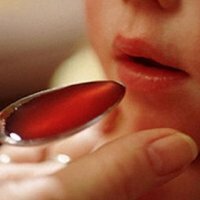Umjetno hranjenje novorođenčeta
 Young mothers, and without exception, understand that in the first months of a baby's life there is no more nutritious food than breast milk.But there can be a situation where the only true solution will be the transfer of the baby to artificial feeding.This process is not so simple as it seems at first glance!It will be necessary to choose the right mixture, get information about the possible consequences of artificial feeding, pick up a newborn individual diet.
Young mothers, and without exception, understand that in the first months of a baby's life there is no more nutritious food than breast milk.But there can be a situation where the only true solution will be the transfer of the baby to artificial feeding.This process is not so simple as it seems at first glance!It will be necessary to choose the right mixture, get information about the possible consequences of artificial feeding, pick up a newborn individual diet.
Of course, you need to get advice from a pediatrician before starting artificial feeding, but the information in this material is always useful.
Table of contents: Indications for switching to artificial feeding Pros and cons of artificial feeding How to choose a formula for artificial feeding How to prepare food How to feed a child with mixturesIndications for transition to artificial feeding
Even if parents will give their baby adapted modern mixturesFrom well-known manufacturers, they can not replace breast milk.Therefore, doctors do not get tired of repeating that the transition to artificial feeding should be reasoned.
Pediatricians identify several situations that make artificial feeding necessary: - The childbirth has been very difficult and the woman is forced to restore her health for a long time.
- A young mother is forced to take certain medications, which can not be canceled, as this is a danger to a woman's life.
- The young mother has infectious diseases.
- In the breast, the mother does not have milk, or there is a pronounced insufficiency( hypolactation).Lack of milk can be confirmed only in the children's polyclinic, when the control feeding is under the supervision of a doctor and the subsequent weighing of the baby.
- Absence of a mother for several weeks or more.
Doctors always try to restore the normal production of milk in the breast to the very last and prescribe to the woman special preparations that enhance lactation.If such measures do not yield positive results, then only in this case resort to the transition to artificial feeding.
We recommend to read:Note: if initially there is milk in the mother's breast, but its amount is too small, then it is not necessary to completely switch the baby to the mixture from the first day - even several milliliters of breast milk will be beneficial for the child's health.
Advantages and disadvantages of artificial feeding
Many mothers deprive their baby of breast milk only to please their desires and their comfort.At the same time, they do not think at all that the baby will not receive important microelements and vitamins, which can lead to developmental delay and health problems.Doctors recommend first weigh all the pros and cons of artificial feeding and then make a final decision.
The obvious advantages of artificial feeding include:
-
 Feeding the child by other people.That is, Mom can absolutely go away for any time, and relatives at any time will feed the newborn, he will not be able to cry from hunger.
Feeding the child by other people.That is, Mom can absolutely go away for any time, and relatives at any time will feed the newborn, he will not be able to cry from hunger. - The ability to immediately identify health problems.The child uses a mixture of bottles, which allows the mother to strictly control the amount drunk, and with a refusal of food to suspect some problems.
- Allergy in a baby who is naturally breastfed can occur on any product and therefore the mother will have to revise and adjust her whole diet.But with artificial feeding to identify the mixture, which led to the appearance of an allergic reaction, it is easy enough.
Are you happy? And now you need to get acquainted with the disadvantages of artificial feeding - by the way, they are much more:
- Children who are breastfed are often ill with colds and face allergies at an older age.This fact doctors explain by the fact that in the body of the baby there is no special enzyme, which can enter into it only from the mother's milk.
- Constant use of bottles requires compliance with the rules for their sterility.If this requirement is ignored, then practically with 100% certainty it is possible to predict the development of dyspeptic disorders in a baby.
- Children on artificial feeding often suffer from intestinal colic and periodic regurgitation, and this is facilitated by a poor-quality teat on the bottle, which leads to ingestion of air.
- On a trip with an "artificial" child, you have to take a separate bag with mixtures, water and bottles - excess baggage.
- In order to find a suitable mixture, in most cases you need to constantly change them.
- The artificial feeding of a child is a very costly "measure", as a good mixture can not be a priori cheap, and as the newborn gets older this mixture will be required more and more.
Note: minuses from feeding mixtures are much more than pluses and therefore you first need to try all ways to restore lactation and only in extreme cases resort to artificial feeding.
How to choose a mixture for artificial feeding
The choice of the formula for artificial feeding should be done by the pediatrician who is watching the baby. But parents themselves should be vigilant, observe certain criteria:
-
 Shelf life.This criterion is the most important if you want to avoid health problems of crumbs.Select only those mixtures that have "a reserve" for several months more shelf life.
Shelf life.This criterion is the most important if you want to avoid health problems of crumbs.Select only those mixtures that have "a reserve" for several months more shelf life. - Integrity of packaging.Put aside torn and crumpled packages - the protection of the mixture can be broken, and therefore its quality will be much worse from the declared.
- Age categories.Feeding for artificial feeding is made according to age categories and parents should purchase only appropriate packages.Do not give the child a mixture intended for older age - it consists of enzymes and trace elements, which for a more immature organism can be dangerous, disastrous.
Note : it is advisable to choose a hypoallergenic mixture for the first month of artificial feeding.But the various mixtures with the addition of iron or some useful bacteria to buy independently is not recommended - such appointments should be made by a pediatrician.
How to prepare food
The reaction of a small organism to artificial feeding depends on how well the food is prepared.Parents should simply study the instructions attached to the mixtures and follow its recommendations .We will highlight a few of the most important points:
-
 It is better to use a special water in bottles for breeding a dry mixture that you do not need to boil.If water is taken from a tap or well, then it must be boiled and defended.
It is better to use a special water in bottles for breeding a dry mixture that you do not need to boil.If water is taken from a tap or well, then it must be boiled and defended. - It is absolutely necessary to observe the proportions of the dry mixture and water.If the water is less, or the dry mixture is more, this will lead to a supersaturation of the intestine with nutrients, and this is the direct route to intestinal colic and dyspeptic disorders.The lack of a mixture will lead to the fact that the baby will remain hungry and will require another portion of food much earlier than usual.
- Mixture is prepared directly in a bottle, but first it is poured water temperature of about 50 degrees.Take into account that hot water can not be taken - such a high temperature can destroy all the beneficial bacteria that make up the mixture.
- After dilution, the mixture should be thoroughly shaken and make sure that there are no lumps.Immediately before feeding, you should check the temperature of the finished mixture - it should not exceed 37 degrees.
Please note: The formula for infant feeding can be prepared in advance, but should only be stored in the refrigerator and not more than 24 hours.
How to feed a child with
The most convenient way - from a bottle, but doctors recommend to resort to it only in the event that the child is on high-grade artificial feeding.If the mother gives more breast milk, then the mixture should be offered to the baby with a spoon .There are situations when a newborn refuses both a spoon and a bottle, and it needs to be fed - in that case it will be convenient to use a conventional syringe without a needle, which will ensure the introduction of the mixture into the baby's body by slowly injecting into the mouth.
Feeding technology:
- The toddler is placed in a position with a slightly raised head that will prevent flooding and will be convenient for crumbs.
- Milk / mixture should completely cover the nipple, and air - accumulate at the bottom of the bottle.
- After feeding the baby, be sure to hold it in a vertical position, so that air emitted from it is swallowed during meals.
Many parents are interested in how much the baby should eat while being on artificial feeding. Of course, this is determined on an individual basis, but there are some general indicators:
- in the first month of life per day the child should drink 700 ml of the mixture for 8-10 times;
- 2-3 month of life - the amount of mixture per day is 900 ml for 6-8 times.
 Please note! It is common knowledge that children who are on artificial feeding are introduced to lactation much earlier, therefore, as the baby grows up, the amount of the consumed mixture will decrease.
Please note! It is common knowledge that children who are on artificial feeding are introduced to lactation much earlier, therefore, as the baby grows up, the amount of the consumed mixture will decrease.
It is very important not to leave the baby with the mixes in the bottle in private - many moms just put the pacifier in her mouth and leave the room, the child drinks the mixture of on his own.First, he can just choke or lose a bottle.And secondly, the mother's contact with the child is very important, therefore, during the feeding the child should be kept on hands( by the way, it is an excellent occasion for short-term rest).
Another important point is the change of the nipple, which should be done periodically and regularly( for example, once every 3-4 weeks ).The fact is that the nipple material is quickly thinned out, and the mixture will pour through the hole with a jet.
Often, artificial feeding is perceived as something easy and simple.In fact, there are no problems with the choice of mixtures, it is possible to select a suitable food even for a toddler with allergy or milk immunity.But there is no need to hurry to translate a newborn into artificial feeding - it's better to compete for lactation in order to provide the crumb with strong immunity and all the necessary vitamins and microelements.
Tsygankova Yana Aleksandrovna, medical reviewer, therapeutist of the highest qualification category



